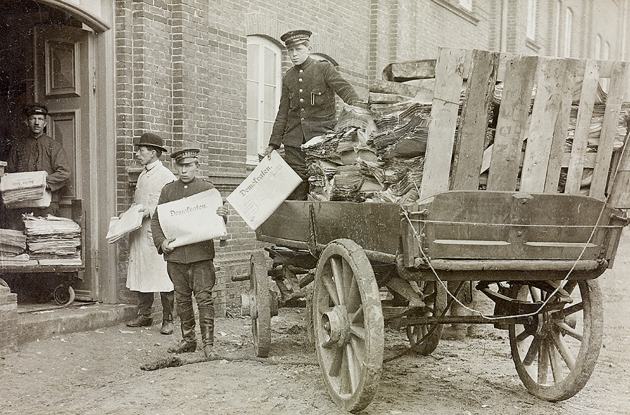The story of the national newspaper collection
The newspapers have been part of the library’s history since the 19th century, but the official establishment of the national newspaper collection did not happen until 1916.

Photo: Ophav ukendt
The troublesome newspapers
Libraries and archives have not always regarded newspapers with kindness, as they were considered unreliable sources. Nevertheless, newspapers became subject to legal deposit by decree in 1781. By the end of the 18th century, newspapers or newspaper-like publications had been common for more than 100 years, which is the reason why the collection is missing large parts of the oldest newspapers. From around 1800 and onwards, there are only a few volumes and annual bound volumes missing in our collection.
From the mid-19th century until the beginning of the 20th century, the number of newspaper publications increased dramatically (in 1849: 42 titles, in 1914: 263 titles). Even small market towns had up to four different newspapers. This put pressure on The Royal Library, the University of Copenhagen Library, the State and University Library in Aarhus as well as the regional archives, which were required by law to obtain and preserve the newspapers.
Once the State and University Library opened in 1902, The Royal Library's duplicates from around the period 1820-1902 were transferred to Aarhus, and here the large number of newspapers caused a few problems, and more newspapers kept coming. They took up a lot of space and had to be bound - in short, they were troublesome and expensive to deal with. During the first decade, there were so many problems regarding space and handling of the newspapers that chief librarian of the State and University Library, Vilhelm Grundtvig, suggested in 1910 that a newspaper repository be set up as a solution. This, along with a simplification of the copyright deposit of newspapers, could also solve the regional archives’ problems with lack of space.
Establishment of the national newspaper collection
Many years went by with negotiations before the national newspaper collection was established by law on May 17, 1916, and it was decided that the collection should be situated in Aarhus. Exactly two years later, in 1918, the first library user entered the newspaper reading room, organized in the former barracks in Høegh-Guldbergs Gade. Eight reading spots had been set up for study use. New newspapers could not be read, as the legal deposit happened biannually, after which the newspapers were bound. The staff searched the newspapers for information and made transcripts whenever possible. The price was DKK 1,50 per hour.
The national newspaper collection was established as an independent institution with the chief librarian of the State and University Library being the primary person responsible for the collection. In 1964, the national newspaper collection was transferred to the State and University Library’s new building in Universitetsparken. Over the years, the collection has increased steadily with more than 600 volumes a year. In 1977, the newspapers were moved again - this time to a new underground storeroom in connection with the library’s existing basements. In the 1,300 square metres of the storeroom, 20 kilometres of shelving were set up as compact racks, making room for the approximately 64,000 volumes.
Placed in a storage room in Skejby, Aarhus
In 2007, the collection moved to a new storeroom in Skejby, which has better conditions for preservation. Here newspapers and local magazines are stored in one place. Users have the option of reading the newspapers that are not available on microfilm or on mediestream.dk because reading spots have been set up in the same building as the storeroom. This reduces wear and tear of the often fragile newspapers because they are kept in-house and do not need to be transported.